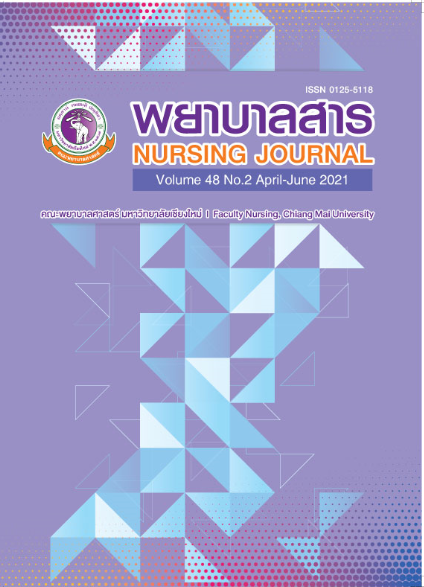การพัฒนาสื่อวีดิทัศน์สำหรับการป้องกันการติดเชื้อในผู้ป่วยมะเร็ง
คำสำคัญ:
การพัฒนาสื่อวีดิทัศน์, การป้องกันการติดเชื้อ, ผู้ป่วยมะเร็งบทคัดย่อ
ผู้ป่วยมะเร็งมีแนวโน้มที่จะเกิดการติดเชื้อได้สูงจากหลายปัจจัย ซึ่งภาวะแทรกซ้อนจากการติดเชื้อเป็นสาเหตุสำคัญทำให้ผู้ป่วยมะเร็งเสียชีวิต ดังนั้นการให้ความรู้เกี่ยวกับการป้องกันการติดเชื้อแก่ผู้ป่วยมะเร็งจึงมีความสำคัญอย่างยิ่ง การวิจัยเชิงพัฒนานี้มีวัตถุประสงค์เพื่อพัฒนาสื่อวีดิทัศน์สำหรับการป้องกันการติดเชื้อในผู้ป่วยมะเร็ง ศึกษาในกลุ่มตัวอย่างคือ ผู้ป่วยมะเร็งที่อยู่ระหว่างการรักษา ณ โรงพยาบาลมะเร็งลำปาง จังหวัดลำปาง จำนวน 41 คน ดำเนินการวิจัยตั้งแต่เดือนกรกฎาคมถึงเดือนธันวาคม พ.ศ. 2560 เครื่องมือที่ใช้ในการวิจัยครั้งนี้ ได้แก่ แผนการออกแบบและพัฒนาสื่อวีดิทัศน์ แบบสอบถามข้อคิดเห็นต่อการใช้สื่อวีดิทัศน์ แบบสอบถามข้อมูลทั่วไปของกลุ่มตัวอย่าง แบบวัดความรู้ในการป้องกันการติดเชื้อ และแบบสอบถามความพึงพอใจของผู้ป่วยมะเร็งต่อสื่อวีดิทัศน์ ซึ่งผ่านการตรวจสอบจากผู้ทรงคุณวุฒิด้านเนื้อหาจำนวน 5 ท่าน และผู้ทรงคุณวุฒิด้านสื่อจำนวน 3 ท่าน โดยแบบวัดความรู้ในการป้องกันการติดเชื้อ และแบบสอบถามความพึงพอใจของผู้ป่วยมะเร็งต่อสื่อวีดิทัศน์มีค่าดัชนีความตรงตามเนื้อหาเท่ากับ 1.00 เท่ากัน และมีค่าความเชื่อมั่นเท่ากับ .82 และ .97 ตามลำดับ ประเมินประสิทธิภาพของสื่อวีดิทัศน์โดยการนำไปทดสอบแบบหนึ่งต่อหนึ่ง แบบกลุ่มย่อย และแบบภาคสนาม วิเคราะห์ข้อมูลโดยสถิติเชิงพรรณนา
ผลการวิจัยพบว่า สื่อวีดิทัศน์สำหรับการป้องกันการติดเชื้อในผู้ป่วยมะเร็งมี 2 ตอน คือ ตอนที่ 1 การติดเชื้อในผู้ป่วยมะเร็ง ประกอบด้วยเนื้อหาเกี่ยวกับปัจจัยที่ทำให้เกิดการติดเชื้อในผู้ป่วยมะเร็ง ผลกระทบจากการติดเชื้อต่อผู้ป่วยมะเร็ง เชื้อก่อโรค และวิธีการได้รับเชื้อเข้าสู่ร่างกาย ตอนที่ 2 การปฏิบัติในการป้องกันการติดเชื้อ ประกอบด้วยเนื้อหาเกี่ยวกับการป้องกันการติดเชื้อทางการสัมผัส การป้องกันการติดเชื้อทางละอองฝอย การป้องกันการติดเชื้อทางอากาศ การป้องกันการติดเชื้อจากอาหารและน้ำดื่ม การป้องกันการติดเชื้อจากสัตว์สู่คน การสังเกตอาการผิดปกติ และการทำความสะอาดมือ ผลการประเมินประสิทธิภาพของสื่อวีดิทัศน์สำหรับการป้องกันการติดเชื้อในผู้ป่วยมะเร็ง มีประสิทธิภาพเท่ากับ 1.44 ซึ่งผ่านเกณฑ์มาตรฐานของเมกุยแกนส์ที่กำหนดค่าไว้ให้มากกว่า 1.00 โดยกลุ่มตัวอย่างมีความพึงพอใจต่อสื่อวีดิทัศน์สำหรับการป้องกันการติดเชื้อในผู้ป่วยมะเร็งในระดับมากถึงมากที่สุดทั้งในด้านเนื้อหา (4.63 – 4.83) ด้านการออกแบบและนำเสนอ (4.47 – 4.73) และด้านประโยชน์ที่ได้รับ (4.87 – 4.93)
ผลการศึกษานี้แสดงให้เห็นว่าสื่อวีดิทัศน์สำหรับการป้องกันการติดเชื้อในผู้ป่วยมะเร็งมีประสิทธิภาพในการนำไปให้ความรู้แก่ผู้ป่วยมะเร็ง และควรนำไปเผยแพร่ให้แก่ผู้ป่วยมะเร็งที่มารับบริการในโรงพยาบาล เพื่อให้ผู้ป่วยมะเร็งมีความรู้เกี่ยวกับการป้องกันการติดเชื้อมากขึ้น นำไปสู่การปฏิบัติในป้องกันการติดเชื้อได้อย่างถูกต้องต่อไป
เอกสารอ้างอิง
American Cancer Society. (2015). Preventing infections in people with cancer. Retrieved from http://www.cancer.org/treatment/treatmentsandsideeffects/physicalsideeffects/infectionsinpeoplewithcancer/preventing-infections-in-people-with-cancer
Bastable, S. B. (2014). Nurse as educator: Principles of teaching and learning for nursing practice. Burlington, MA: Jones & Bartlett Learning
Cancernetwork. (2016). Infectious complications. Retrieved from http://www.cancernetwork.com/cancer-management/infectious-complications
Craven, R. F., & Hirnle, C. J. (2006). Fundamental of nursing human health and function. Philadelphia: Wolters Kluwer health/Lippincott Williams & wilkins.
Herbst, C., Naumann, F., Kruse, E. B., Monsef, I., Bohlius, J., Schulz, H., . . . Engert, A. (2009). Prophylactic antibiotics or G-CSF for prevention of infection and improvement of survival in cancer patients undergoing chemotherapy. Cochrane Database of Systematic Review.
doi: 10.1002/14651858.CD007107.pub2
Ketpark, N. (2011). Effects of video media on knowledge and practices of patients in prevention of infection, Nursing Journal, 38, 98-109.
Knowles, M. S., Holton, E. F., & Swanson, R. A. (2005). Adult learner: The definitive classic in adult education and human resource development (6th ed.). Boston: Elsevier.
Kuderer, N. M., Dale, D. C., Crawford, J., Cosler, L. E., & Lyman, G. H. (2006). Mortality, morbidity and cost associated with febrile neutropenia in adult cancer patients. Cancer, 106(10), 2258–66.
Leonard, K. (2012). A European survey relating to cancer therapy and neutropenic infections: Nurse and patient viewpoints. European Journal of Oncology Nursing, 16(4), 380–386.
National Comprehensive Cancer Network. (2015). Practice guideline in oncology. Prevention and treatment of cancer-related infections, 2, MS2-MS8. Retrieved from http://www.nccn.org/professionals/physician_gls/pdf/infections.pdf
Potter, P. A., & Perry, A. G. (2007). Basic nursing: Essentials for practice (6th ed.). St. Louis: Mosby.
Skalla, K. A., Bakitas, M., Furstenberg, C. T., Ahles, T., & Henderson, J. V. (2004). Patients’need for information about cancer therapy. Oncology Nursing Forum, 31(2), 313-19.
Stewart, B., & Chistopher, P. W. (2014). Rising burden of cancer. World Cancer Report 2014. Retrieved from http://www.ias.org.uk/
Zembower, T. R. (2014). Epidemiology of infections in cancer patients. Cancer treatment and research. doi: 10.1007/987-3-319-04220-6_2
ดาวน์โหลด
เผยแพร่แล้ว
รูปแบบการอ้างอิง
ฉบับ
ประเภทบทความ
สัญญาอนุญาต
บทความที่ได้รับการตีพิมพ์เป็นลิขสิทธิ์ของวารสารพยาบาลสาร
ข้อความที่ปรากฏในบทความแต่ละเรื่องในวารสารวิชาการเล่มนี้เป็นความคิดเห็นส่วนตัวของผู้เขียนแต่ละท่านไม่เกี่ยวข้องกับมหาวิทยาลัยเชียงใหม่ และคณาจารย์ท่านอื่นๆในมหาวิทยาลัยฯ แต่อย่างใด ความรับผิดชอบองค์ประกอบทั้งหมดของบทความแต่ละเรื่องเป็นของผู้เขียนแต่ละท่าน หากมีความผิดพลาดใด ๆ ผู้เขียนแต่ละท่านจะรับผิดชอบบทความของตนเองแต่ผู้เดียว






